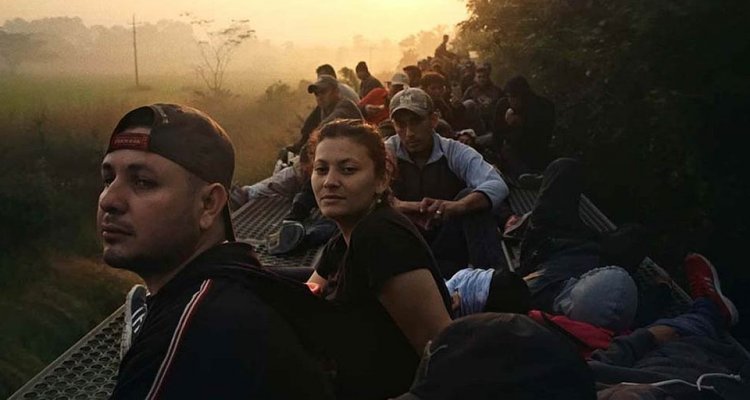The sophomore installment of Showtime’s gripping documentary series “The Trade” begins with a tense border crossing sequence that somewhat resembles a “Breaking Bad” cold opening – sporting a heart-pounding score and high contrast visual panache that immediately puts you on the edge of your seat. One man lifts another on top of his shoulders, over a massive fence drenched in shadows on the U.S./Mexico border. One assumes, given the terrific camera work, compositional detail and attention even a one-person camera crew would attract, that the sequence was at least partially staged, But you would be dead wrong.
READ MORE: The 60 Most Anticipated TV Shows Of 2020
Season 1 of the Showtime series tackled the opioid trade epidemic. The newest batch of episodes dives into an even more disturbing subject: human trafficking. Directed by award-winning documentarian and extraordinary cameraman Matthew Heineman (“Cartel Land,” “City of Ghosts“) “The Trade” certainly owes at least a little to Steven Soderbergh’s systemic hyperlink films for those that don’t already know Heineman’s superb work. “Traffic,” obviously being the clear comparison, but “The Trade’s” musical score also closely resembles many of composer Cliff Martinez’ contemporary, synth-pounding arrangements, the swelling flow of the docuseries, cross-cutting montage work which resembles something akin to “Contagion’s” transition sequences. (Soderbergh’s 2011 film is back in the news for all sorts of reasons these days.)
The Best TV Shows & Mini-Series’ Of The Decade [2010s]
Each episode of the second volume follows at least one Central American immigrant’s intimately personal, usually tragic story. Simultaneously, a large-scale trafficking investigation in McAllen, Texas —essentially the central hub of the migrant trafficking problem — looms in the background, as a woman from Honduras, named Magda, attempts to make her way to America with her family, fleeing from gang violence which took the life of her husband. The key subjects of focus being are just about the only talking heads of the series. Showing the real-life consequences of something like human “stash houses”— intensely dramatized in a film like “Sicario” — and examining the impact these alarming enterprises have, on both the micro and the macro side of things, is the show’s primary bread and butter.
READ MORE: The Best TV Shows & Mini-Series Of 2019
Constantly moving back and forth between Mexico, Honduras, Guatemala, their borders, Texas, Colorado, and even Columbus, Ohio (Homeland Security headquarters) the first episode of the second season is very scattered. In aiming to establish several key components, cutting back across the narratives of several parties affected by these migrant issues — a sushi chef named Victor, who is petitioning against being detained, for example — initially, there is very little narrative cohesion, more broad structural strokes. But the season starts to better juggle these tangential threads by the third hour, it just becomes no easier to watch, pivoting full-on into even more upsetting territory. The primary stash house investigation — that the audience follows through Special Agent Ramirez of Homeland Security’s ICE division — starts overlapping with some of the series individual subjects, diving into the heinously abhorrent crime of underage victims being sold into child pornography and sex trafficking.
According to Agent Ramirez, McAllen, Texas is the closest access point between Central America and the United States, and he estimates that there are, roughly, least 200 stash houses operating at any given time by traffickers — many times the migrants often being locked inside, as if they were in prison. When a tip from an informant leads to a house raid, empty condom wrappers are the worst kind of sign. For far too many people, humans are just another product for criminals without a caring bone in their body to exploit in order to make a profit. Many fleeing their countries are, indeed, pursuing a dream of opportunity, and for so many others, finding a life in America is simply a matter of survival.
“Nothing we do is scripted, nothing we do is planned,” Heineman recently told the New York Times about “The Trade,” and this always-gripping documentary is so amazingly well shot— with such an uncanny ability to get into difficult places— this statement is almost hard to believe. But if you’ve seen “Cartel Land” and Heineman’s immersive previous works, you know the inherently discomforting nature of “The Trade” Season 2’s subject matter, paired with its unflinching approach towards the human horrors it shines a light on, is the exact kind of magic trick he routinely pulls off.
It also feels a tad bloated, even though there is an enormous amount of information to get across in each hour. The first episode shows, and describes, something in its ending montage, then the second episode presents this same idea in more detail, which feels like needless double-dipping for pity points. Crying children being clutched to their parent’s chests, right beside a border office with a riot shield, is a powerful image, but relying on such imagery too often deafens the ruinous nature of the situation.
Still, stories such as those told throughout this series need to be told, perhaps now more than ever, but it is entirely understandable if Showtime’s program is simply too much for some viewers to stomach. It’s not exactly grimdark, but it is enormously effective in a way that is often deeply uncomfortable for obvious reasons. The life and death consequences are made incredibly clear, and the graphic aftermath of the forensic analysis can be effectively cringe-worthy. “The Trade” might make you tear up at a few points, and it’s sure to light a fire beneath some viewers’ political trousers, but its dire hopelessness does start to wear and weather after a while, and its immense power gets a bit regurgitative. [B]

